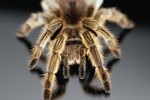
Scorpions use their stingers, or telsons, to inject venom in perceived predators and potential prey. Scorpion venom varies from species to species and even from one population to the next; some are capable of causing medically significant symptoms in people, while others are no more serious than bee stings. Because of their broad variation in venom among species, few correlations exist between a scorpion’s size and the level of danger the creature represents.
Relative Danger
True scorpions (Scorpiones) vary in size from tiny species under an inch in length, to massive species who reach more than 7 inches from head to tail. Both deadly and relatively harmless species exist at both ends of the size spectrum. The most dangerous species in the United States -- Centruroides exilicauda -- is a little over 2 inches.
False Scorpions
Though related to true scorpions, false scorpions (Pseudoscorpionida) lack venomous stingers entirely and are completely harmless to humans. With even the largest species barely reaching a half-inch in length, these tiny arachnids consume very small prey such as springtails and mites.
References
Photo Credits
-
Stockbyte/Stockbyte/Getty Images




